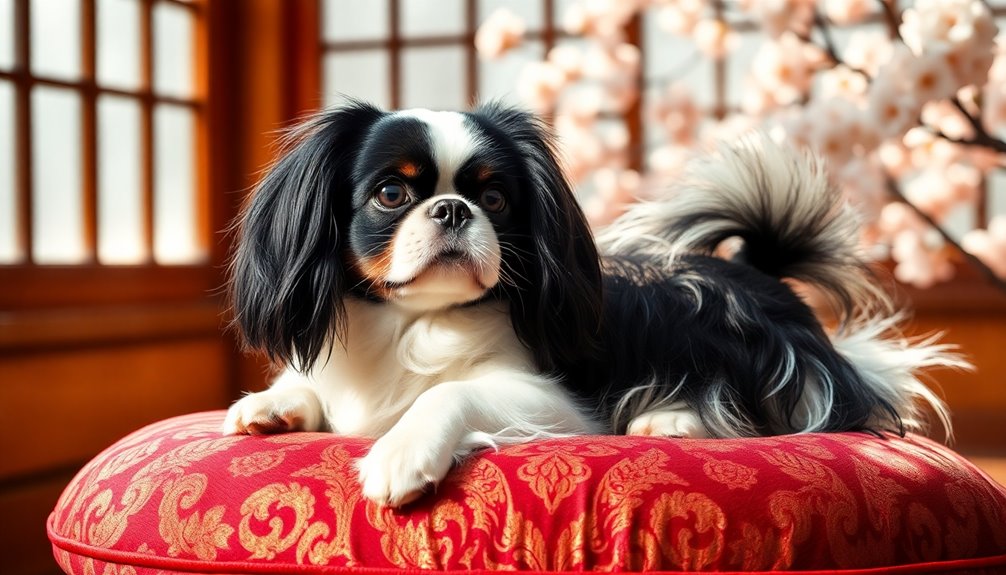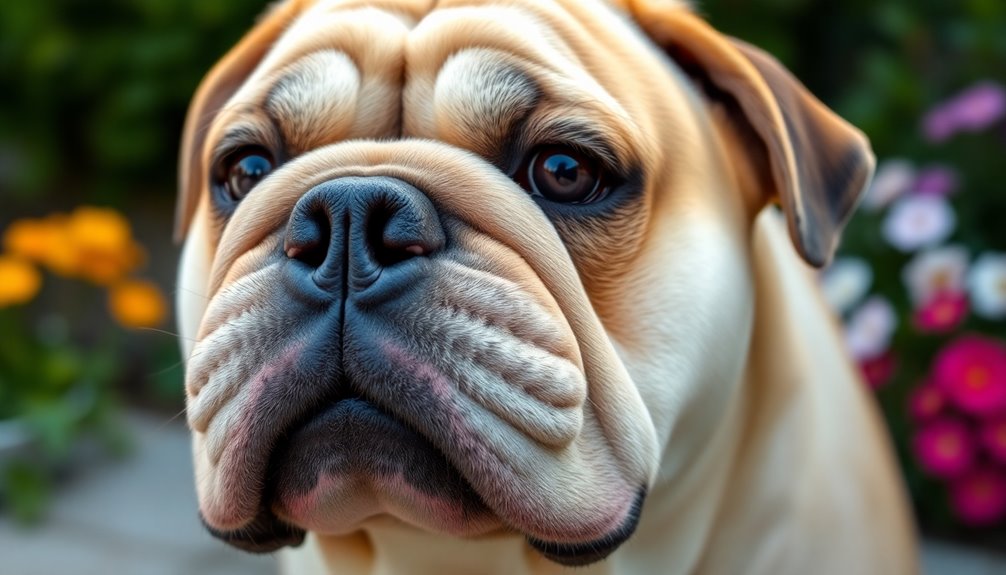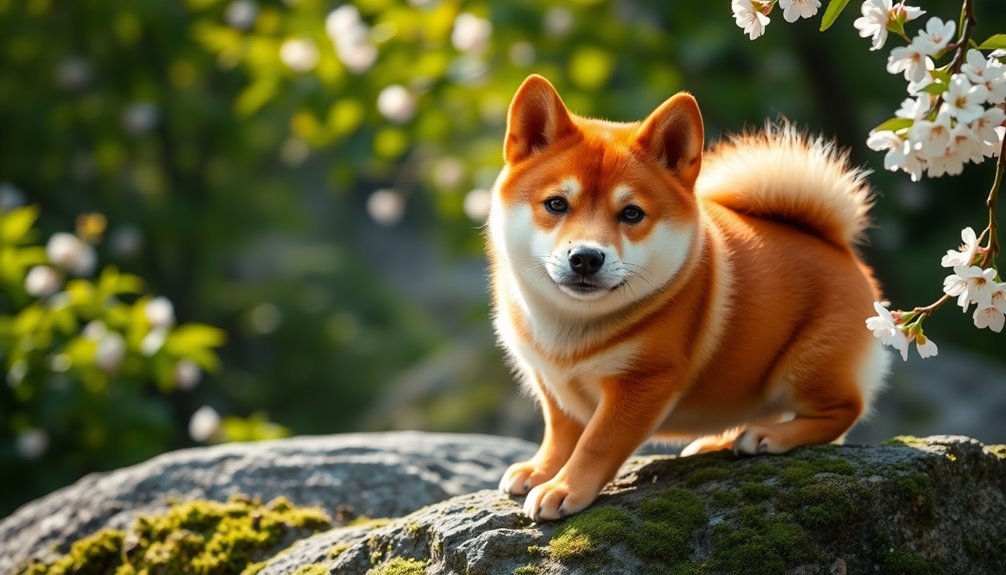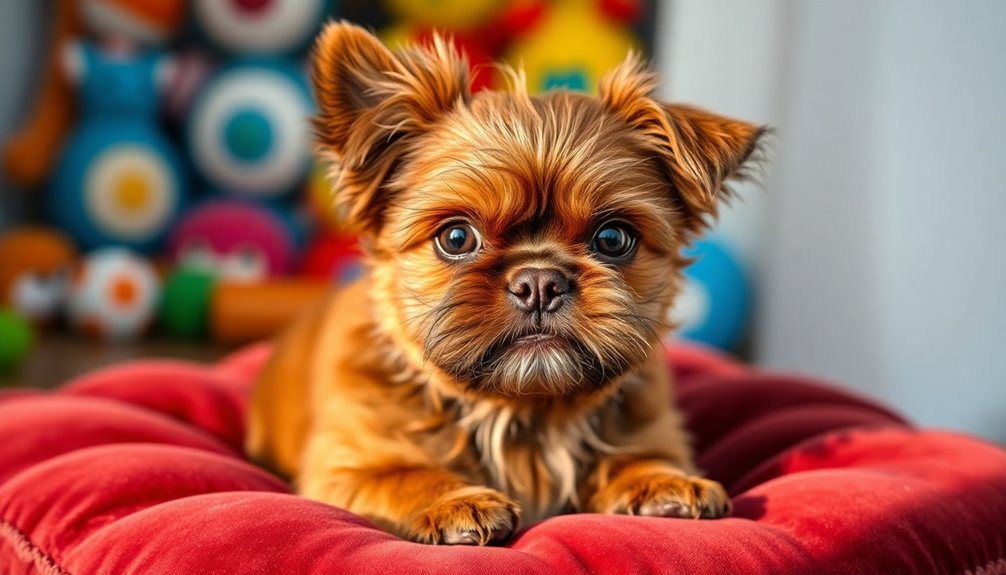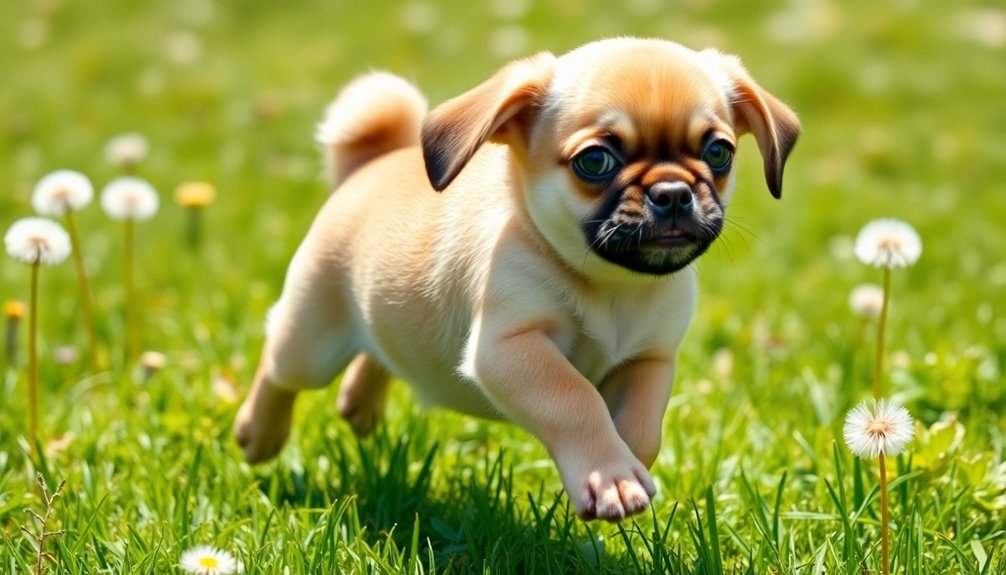The Japanese Chin, often regarded as the regal lapdog, enchants with its elegant stature and playful personality. Standing just 8 to 11 inches tall and weighing between 4 to 11 pounds, this breed boasts a silky coat and a lively tail that adds to its charm. With origins linked to Japanese royalty and a background of luxurious companionship, the Chin thrives on affection. They're great for families, adaptable to various living conditions, and require regular grooming and socialization. If you're curious about their care needs or how to train them, keep exploring to uncover more insights!
Key Takeaways
- The Japanese Chin is a small, elegant breed known for its playful and charming personality, making it an ideal companion lapdog.
- With a history of royal companionship, this breed was cherished by Japanese nobility and symbolizes luxury and prestige.
- Their long, silky coat requires regular grooming, including weekly brushing and monthly baths, to maintain their regal appearance.
- Japanese Chins thrive in indoor environments, adapting well to apartment living and requiring companionship to prevent loneliness.
- Known for their intelligence and agility, Japanese Chins enjoy learning tricks and engaging in interactive play with their owners.
Introduction
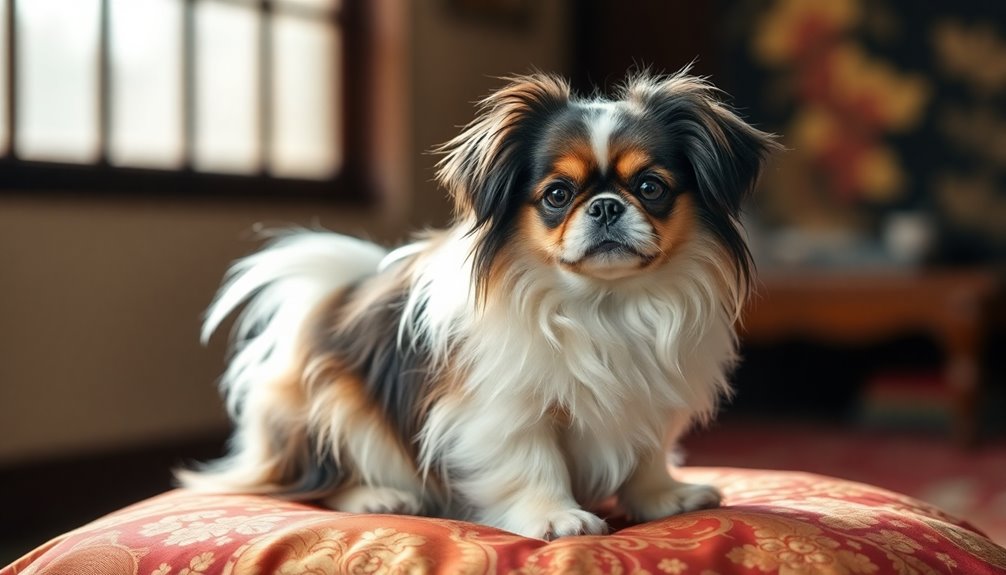
The charm of the Japanese Chin lapdog lies in its elegant demeanor and affectionate nature. Standing between 8 to 11 inches tall and weighing just 4 to 11 pounds, this little breed fits perfectly in your lap. Its large, broad head features a short muzzle and wide-set, dark eyes that give it a sweet, expressive look. The floppy ears, adorned with feathering, further enhance its regal appearance.
The Chin's coat is medium to long, silky, and straight, coming in colors like black and white, red and white, or tricolor. While its beautiful coat draws admirers, you'll need to put in some effort to keep it tangle-free. With a distinctive ruff around its neck and feathering on its ears, thighs, and tail, this breed truly stands out. Toy classification by the AKC emphasizes its status as a beloved companion breed.
Known for being sweet and playful, the Japanese Chin has a high social need and may be reserved with strangers. It's not overly vocal, but its snoring can be quite noticeable.
As a moderate activity dog, it only requires about 20 minutes of exercise each day, making it a perfect companion for apartment living.
History and Origin
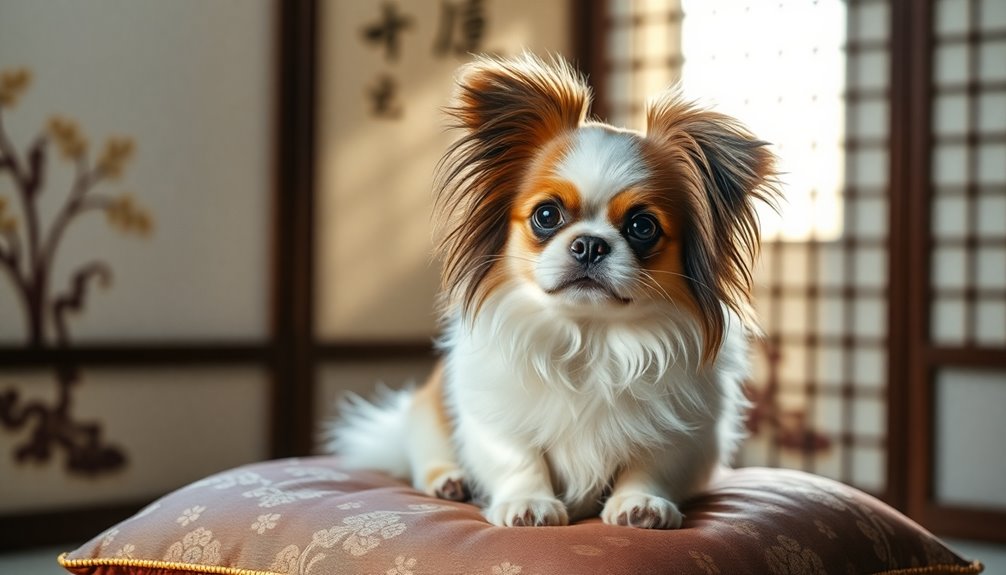
The Japanese Chin breed traces its roots back to ancient China, with origins believed to date as far back as 690 AD.
These small dogs were cherished companions of the nobility, often pampered and treated like royalty in Japanese palaces.
As you explore their history, you'll see how their royal companionship shaped their development and status over the centuries. They are known for their aristocratic history, having been nurtured by Japanese nobility for over 1,000 years.
Where and when the breed originated
Tracing the origins of the Japanese Chin reveals a fascinating journey that begins in ancient Asia, likely in China. While there's some debate about its roots, it's widely accepted that these small dogs traveled the Silk Road, accompanying travelers and becoming companions for Buddhist monks.
In their monasteries, monks nurtured and mated various types of small dogs, which were often gifted to dignitaries. The path to Japan is equally intriguing. Some claim the Chin was gifted by Kim Jangson, an envoy from the kingdom of Silla, around AD 732. Others suggest these dogs made their way to Japan as early as the sixth century or that they first arrived around AD 1000, possibly brought by monks or Korean rulers. Additionally, some assert that the breed arrived around AD 1000, which highlights the long-standing connection between Japan and this exquisite dog.
There's also the possibility that direct gifts from Chinese emperors introduced the breed. In the West, the Japanese Chin began to gain recognition when Commodore Matthew Perry received some in 1853 and gifted them to Queen Victoria, who helped popularize the breed.
These early introductions marked the start of the Japanese Chin's journey to becoming a cherished lapdog in Western countries.
Royal Companionship for Nobility
Within the delicate confines of Japanese royalty, the Japanese Chin thrived as a beloved companion, cherished for its grace and charm. Bred exclusively for the nobility, these dogs brought joy and elegance to the homes of the elite. Their ownership was reserved for aristocrats, and they often appeared in Japanese artworks and literature, solidifying their esteemed status.
Pampered like royalty, Chins enjoyed delicacies, silk-pillowed beds, and hand-fed ice during hot weather. Servants were strictly instructed to avoid disturbing their slumber, and harming them could result in severe penalties. Their moderate energy levels allowed them to adapt well to the luxurious lifestyle of their owners.
Smaller Chins, weighing under three pounds, were especially prized, easily carried in kimono sleeves or small baskets. Some even had their own servants and elegant bird cages.
Historically, the Japanese Chin descends from dogs that warmed the laps of Chinese aristocracy. They symbolized a connection to the Buddhist "lion dog" and played significant roles in the imperial court, often gifted to important foreign visitors.
Their introduction to Europe began in the 16th century, gaining favor with Queen Victoria and Queen Alexandra, which further spread their popularity across the continent.
Physical Characteristics
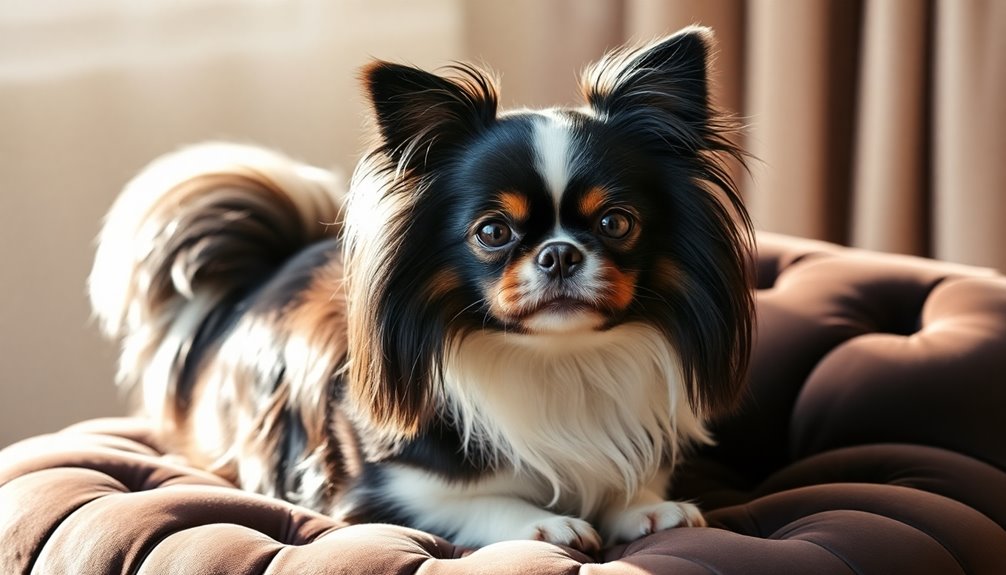
The Japanese Chin is a small yet elegant breed, typically weighing between 4 to 11 pounds and standing 8 to 11 inches tall. You'll notice their silky coat, which can be medium to long, often in striking combinations like black and white or red and white. Interestingly, male Japanese Chins can weigh around 7-9 lbs by the time they reach 2 years old. Their feathered tail forms a bushy plume, adding to their charming appearance and lively personality.
Size, weight, and coat details
The Japanese Chin is a small, elegant lapdog, typically standing between 8 to 11 inches tall at the withers and weighing around 7 to 9 pounds. Males usually reach about 10 inches, while females are generally around 9 inches. By the time they're 9 months old, they're fully grown.
Newborns weigh between 0.4 to 1.5 pounds, and by 3 months, they weigh around 2 to 3 pounds. At 6 months, they'll be about 4 to 5 pounds, and by their first year, they often weigh between 5 to 7 pounds. Though it's rare, they can max out at 12 pounds.
When it comes to their coat, Japanese Chins have medium-length hair that's silky and straight. Their base color is white, adorned with patches that can be black, red, lemon, orange, sable, or brindle. The nose color matches the coat markings, which adds to their charm. Their distinctive long, flowing coat is abundant around the neck, shoulders, and chest, while the hair on their head and muzzle is shorter. Being a single-coated breed, they require regular grooming to maintain that regal appearance.
Feathered Tail and Plume
With its tail set high on a level back, the Japanese Chin boasts a beautifully feathered plume that adds to its refined appearance. This tail isn't just any tail; it's profusely feathered, closely curved, and plumed over the back, forming a bushy plume over the rump. The long, flowing hair features a silky texture that enhances the dog's luxurious coat, making it a standout in any setting. Additionally, the breed is known for its intelligent and lively disposition, which complements the elegant look of the tail.
As your Chin moves, you'll notice the stylish movement that showcases good reach and elevation. The tail flicks elegantly to either side of the body, accentuating the dog's regal and graceful gait. This movement not only highlights the feathering but also enhances the lively and upright demeanor inherent to the breed.
When judging the Japanese Chin, it's essential that the outline of the body remains visible despite the abundant feathering. The tail should complement the dog's shape without obscuring it, and a well-feathered tail is crucial for accurate breed evaluation.
Keep in mind that younger dogs may not exhibit as much feathering as their older counterparts, but the potential for a striking plume is always there.
Temperament and Personality

The Japanese Chin is known for its playful and charming demeanor, making it a delightful companion for families and individuals alike. You'll find that they often get along well with other pets, adding to their appeal as a versatile lapdog. Their affectionate nature thrives on attention, ensuring they fit into a variety of home environments. These small dogs are particularly suited for calm households, where their gentle temperament can truly shine.
Playful and Charming Demeanor
Known for their playful and charming demeanor, Japanese Chins bring a delightful energy to any household. You'll be amazed at their ability to perform tricks like the "Chin Spin" or dance on their hind legs, showcasing their intelligence and agility. These little dogs thrive on attention and love to be the center of your world, often engaging in lively antics that keep you entertained.
With their cat-like traits, Japanese Chins exhibit fascinating behaviors, such as washing their faces with their paws and enjoying the view from high surfaces. Their natural sense of balance allows them to climb and explore with ease, while their independent nature sometimes leads them to hide in unexpected places. Additionally, their origins can be traced to selectively bred dogs in monasteries, highlighting their unique heritage.
Loyalty and affection define their relationships with you. They form strong bonds and enjoy curling up on your lap, often displaying a gentle demeanor. Even though they may be reserved around newcomers, they warm up quickly with a proper introduction.
Their unique quirks, like the adorable "snizzle" sound they make, add to their charm. Early socialization helps them adapt while maintaining their playful spirit, ensuring they remain the beloved companions you adore.
Suitability for families, individuals, or other pets
Japanese Chins can be excellent companions for families and individuals, but their suitability varies based on the household dynamics. They generally do well with families that have older children, as their delicate nature makes them vulnerable to unintentional injuries from small kids. Supervised interactions are crucial to keep both the children and the dog safe.
If you have other pets, you'll find that Chins can get along well with them, especially if they're socialized early. However, due to their fragility, caution is needed when larger breeds are around. These dogs thrive on companionship, so they do best living with other Chins or in homes where they receive plenty of attention. Their moderate exercise needs and minimal grooming requirements make them adaptable to various lifestyles, including apartment living. Additionally, their unique long, silky coat requires regular grooming to maintain its health and appearance.
If you're considering a Japanese Chin for emotional support, their calm demeanor and affectionate nature can provide comfort, particularly for those dealing with anxiety or depression. Just be mindful of their tendency to develop separation anxiety, which can be managed through crate training and gradual separation.
Health and Lifespan
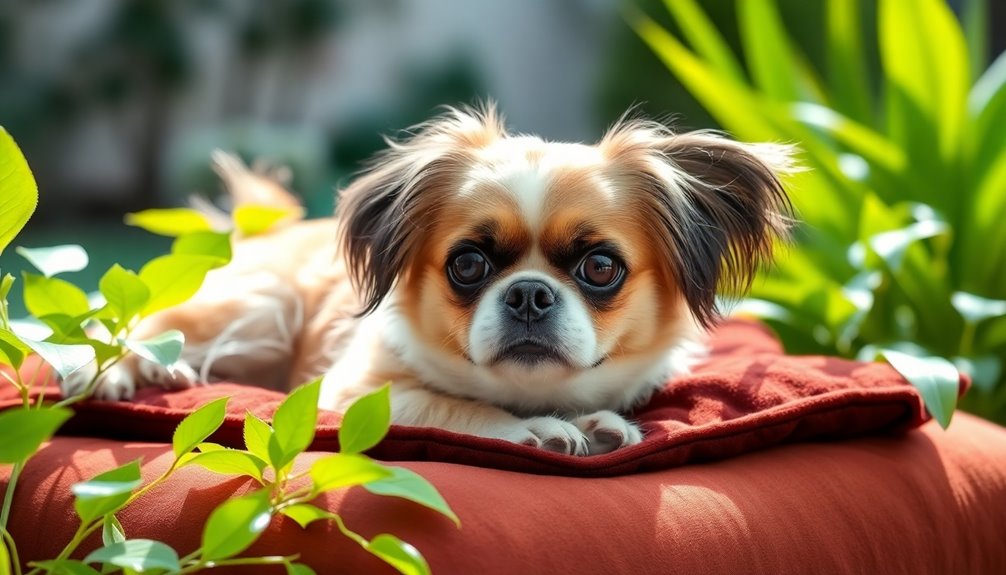
When it comes to the Japanese Chin, you'll find that their average lifespan ranges from 10 to 12 years, influenced by various health concerns. Common issues like breathing difficulties and eye problems can affect their quality of life, so it's crucial to stay informed. Regular veterinary check-ups can help catch any potential health issues early on.
Typical lifespan of the breed
The typical lifespan of a Japanese Chin lapdog ranges from 10 to 12 years, but with proper care, they can live up to 14 years. A recent study in the UK found that the average lifespan is around 12.5 years, which is comparable to other small breeds, though some similar-sized breeds may live longer.
To ensure your Chin thrives, focus on a high-quality diet that prevents obesity and meets their nutritional needs. Portion control is crucial, so keep an eye on their weight. Daily exercise, about 20 minutes, helps maintain their health and vitality. Also, since they're brachycephalic, avoid hot weather to prevent respiratory issues. Regular veterinary check-ups and preventive measures can significantly contribute to their longevity. It's important to note that these dogs are also prone to certain health issues, including patellar luxation, which can affect their mobility.
Though Japanese Chins are generally robust, they need diligent care. A balanced diet rich in proteins and vitamins is essential; consider premium kibble designed for small breeds and complement it with lean meats. Lastly, dental health shouldn't be overlooked. Daily tooth brushing and routine cleanings are key to keeping their teeth and gums healthy.
With the right care, your Japanese Chin can enjoy a long, happy life by your side.
Common health concerns or genetic predispositions
For owners of a Japanese Chin, being aware of common health concerns and genetic predispositions is crucial for ensuring their pet's well-being. This breed is prone to several orthopedic issues, like Legg-Calve-Perthes disease, which often appears between six and nine months, causing pain and lameness. Additionally, heart disease is a leading cause of death in older Chins, often due to valve issues, and early diagnosis allows for effective management.
Patella luxation and hemivertebrae are other concerns that can affect mobility and spinal stability. Metabolic and endocrine issues are also prevalent. Hypothyroidism can lead to dry skin, weight gain, and behavioral changes, while obesity can exacerbate joint and heart problems.
Regular dental care is essential, as dental disease can result in severe infections affecting vital organs. Respiratory and cardiac issues are significant as well. Due to their brachycephalic nature, Japanese Chins are susceptible to breathing difficulties and heat stroke.
Heart disease is another common risk, particularly in older dogs. Lastly, keep an eye out for neurological disorders like GM2 gangliosidosis, which can appear in young adulthood.
Being vigilant about these health concerns can help you provide the best care for your beloved Chin.
Tips for maintaining health and wellness
Maintaining your Japanese Chin's health and wellness requires a balanced approach that includes proper diet, regular exercise, and good grooming habits.
Start with a high-quality dog food, limiting daily intake to about 1 cup of dry food. Treats should make up less than 10% of their diet, so avoid giving them human food to prevent obesity. Tailor their diet to their age for optimal nutrition. Additionally, it's important to monitor their weight regularly, as they're prone to obesity. Obesity can lead to other health issues, such as joint problems and diabetes.
For exercise, aim for at least 20 minutes a day. Daily walks and short play sessions will keep your Chin fit and healthy. If you live in an apartment, that's perfectly fine—just ensure you provide regular outdoor activity while avoiding overexertion, especially during hot weather.
Grooming is crucial too. Brush their coat weekly to prevent matting, give them a bath monthly, and trim their nails regularly.
Don't forget to brush their teeth daily to ward off dental disease and clean their ears weekly to avoid infections.
Since Japanese Chins are indoor dogs, don't leave them outside for long periods. Regular vet check-ups and vaccinations are essential to keep them healthy, and pet health insurance can help manage medical costs.
Care Requirements
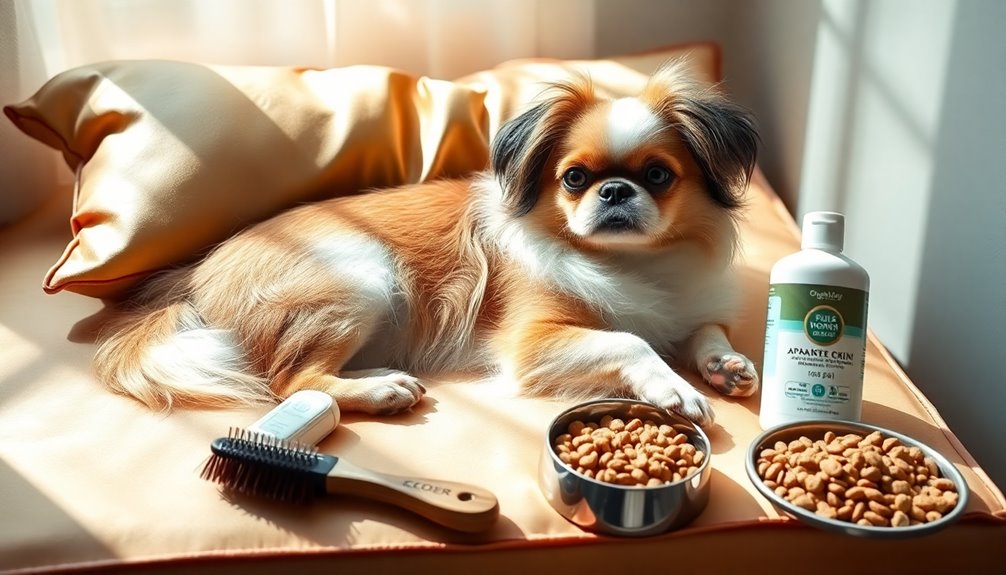
Caring for your Japanese Chin involves regular brushing to keep their coat smooth and healthy. You'll also need to ensure they get enough exercise to match their energy levels, along with a well-balanced diet to keep them in top shape. Additionally, maintaining their coat requires regular bathing to remove dirt and debris, ensuring their skin stays healthy. Let's explore these care requirements to help your pup thrive.
Regular Brushing Required
Regular brushing is essential for keeping your Japanese Chin's coat healthy and tangle-free. Aim to brush at least once a week for thorough grooming, but quick daily brushing is recommended to maintain a smooth, clean coat.
During shedding periods, especially for females, you'll want to brush more frequently to manage the extra hair and prevent it from coating your house.
Use a pin brush to effectively comb through the coat and remove tangles. A spray bottle with thinned-down conditioner or detangler can help with mat removal, while a mat ripper or comb is useful for gently working out stubborn mats.
Pay special attention to the ear fringe hair, as this area is prone to tangling. When grooming, check for mats around the face and neck to avoid skin irritation.
Regularly trim hair under the feet and clip toenails. You should also inspect your Chin's skin for any signs of irritation or sores. Additionally, ensure to monitor skin for irritation or sores during grooming sessions to keep your Chin comfortable and healthy.
Bathing is typically needed once a month, but you can use dry shampoo between baths to keep your pup fresh. Consider occasional professional grooming to maintain that regal appearance.
Exercise requirements and energy levels
Grooming your Japanese Chin is just one part of their care—exercise plays a vital role in their overall well-being too. While these adorable lapdogs aren't highly energetic, they still need regular, gentle exercise to stay fit. Aim for at least 20 minutes of exercise each day, which can include short walks where they can sniff around and explore. Japanese Chins are known for their quiet nature, making them well-suited for leisurely strolls.
Playful interactions are essential for both their physical and mental stimulation, so incorporate some short play sessions and gentle training activities into your routine. Be mindful of their brachycephalic nature; avoid overexertion to prevent respiratory issues. When exercising, use a harness to protect their sensitive necks, and keep them on a leash to prevent them from running off.
Hot weather can be particularly tough for Japanese Chins, so opt for indoor play on those scorching days. Engage their minds with puzzle toys or quizzes to provide mental stimulation.
Feeding tips and diet recommendations
Feeding your Japanese Chin a balanced diet is crucial for maintaining their health and vitality. Start by including high-quality protein sources like chicken, turkey, or fish. Essential fatty acids are important too, so ensure their diet has a balance of fats. Add small amounts of carbohydrates from veggies, herbs, and berries for fiber and antioxidants. A diet rich in high-quality protein sources contributes to their overall health and energy levels.
For feeding quantities, puppies need about ¼ to ⅓ cup of food, three to four times daily. Adults typically require ½ to ¾ cup, split into two meals, while seniors should have specially formulated diets lower in calories but rich in nutrients. Always measure portions to avoid obesity.
Choose small kibble sizes, or consider fresh and cooked meals for better nutrition. Avoid table scraps, as they can upset their stomachs.
Keep an eye on their weight and consult with your vet to address any specific health concerns, especially for seniors. Supplements may be beneficial for gut and joint health.
Training and Socialization

When training your Japanese Chin, you'll find they're moderately responsive to commands, so patience is key. Gradual introductions to new environments will help them feel secure and confident. However, be prepared for potential housebreaking difficulties, as they may need extra time and encouragement to master this skill. Their small size makes them well-suited for indoor living, but it also means they can be easily overlooked during training sessions.
Moderately Responsive to Commands
Training your Japanese Chin can be a rewarding experience, as they're generally intelligent and eager to please. You'll find that they respond well to positive reinforcement techniques, such as praise, treats, and play. However, patience and consistency are key. Short, engaging training sessions work best to keep their interest and prevent boredom.
Although your Chin can learn tricks and tasks easily, their independent nature may introduce a bit of stubbornness. To help manage this, use gentle and positive training approaches. It's also essential to tailor training sessions to their age, as overexertion can strain their backs. Additionally, be aware that their delicate nature means that rough handling during training should be avoided to prevent injury.
Socialization is crucial; without it, your Chin might become shy or fearful. Early exposure to various people, sounds, and situations helps them navigate new experiences confidently. This not only fosters a friendly demeanor but also strengthens the bond between you and your pet.
Keep in mind that your Japanese Chin may exhibit separation anxiety if left alone for extended periods. Early training to manage barking at unfamiliar sounds is vital, as consistent attention and interaction are necessary for their well-being.
Gradual Introductions to New Environments
Introducing your Japanese Chin to new environments should be a gradual process to ensure they feel secure and confident. Start by introducing your Chin to familiar spaces, like your home and backyard. Incorporate small changes, such as new toys or blankets, and consider playing soothing music to create a relaxed atmosphere. Reward your dog's calm behavior with treats and praise, allowing them to explore at their own pace.
Once they're comfortable, transition to outdoor environments. Choose quiet parks or less crowded areas initially. Observe their reactions closely, adjusting your approach based on their comfort level. Engage them with familiar toys or games, keeping the initial outings short and rewarding. If your dog shows discomfort, retreat to a quieter spot. Safe exposure is essential during this stage to foster their confidence in new settings.
Use high-value treats like cheese or chicken to make new experiences more enjoyable. Praise and gently pet your dog for relaxed behavior.
When introducing new people or animals, do so slowly, allowing your dog to approach at their own pace. Avoid forcing interactions and reinforce positive experiences with treats. Gradually expose them to diverse sounds and surfaces, rewarding calm behavior as they adapt to new stimuli.
Housebreaking Difficulties
Housebreaking a Japanese Chin can be a challenging yet rewarding process, requiring your patience and commitment. Their small bladders mean they need frequent potty breaks, making consistent training essential. Be prepared for some accidents along the way; this process can be slow.
Positive reinforcement is key—use praise and treats to encourage good behavior, while avoiding harsh commands that can hinder progress.
Create a supervised environment, like a playpen or crate, to minimize accidents and prevent stress. Daily walks and play sessions will keep your Chin physically and mentally stimulated, reducing the chances of indoor mishaps. It's important to note that they have a tendency for separation anxiety, which may lead to accidents if left alone for too long.
Use consistent words and commands to help your Chin understand expectations. Early training is crucial as they learn quickly but may become shy or suspicious if not socialized properly.
Regular grooming and health checks will also support their overall well-being. By staying committed and employing these techniques, you'll set your Japanese Chin up for success in housebreaking and beyond.
Ideal Living Environment

If you're considering a Japanese Chin as your companion, you'll want to create a cozy indoor environment for them. These dogs are sensitive to heat, so keeping your space cool during the summer is essential. With their preference for snug surroundings, they'll thrive in your home, as long as you provide safe areas for play and exploration. Regular grooming is also important to maintain their silky coat, ensuring they remain comfortable in their cozy environment.
Cozy Indoor Spaces Preferred
Where can a Japanese Chin lapdog truly thrive? You'll find that these charming companions adapt beautifully to various living situations, from cozy city apartments to spacious country homes. They don't require vast areas for exercise; a few short walks and playtime indoors are all they need to stay happy and healthy.
Their sensitive nature means they must live indoors, as they thrive on companionship and attention from you. To keep your Chin content, ensure they've access to safe, enclosed spaces for leisurely play. They enjoy engaging with interactive toys or puzzle feeders indoors, making them perfect for flat dwellers. Additionally, regular vet check-ups can enhance their longevity, ensuring that your Chin remains a joyful part of your life for many years to come through proper care.
Although they love mild outdoor activities, they should never be left outside for long periods, as they can become miserable when alone. Socially, Japanese Chins prefer the company of their owners or fellow Chins, so it's crucial to spend quality time with them to prevent separation anxiety.
They're best suited for older individuals or families without young children due to their gentle disposition. By providing a cozy indoor environment filled with love and attention, you'll create the ideal living space for your regal lapdog.
Heat Sensitivity During Summer
Japanese Chins not only love cozy indoor spaces, but they also require special care during the summer months due to their heat sensitivity. Their short snouts make them prone to heat intolerance and heat stroke, so you'll need to be vigilant in warmer temperatures. Moderate exercise requirements for Japanese Chins mean that you should avoid strenuous activity during hot weather.
Breathing difficulties can worsen in the heat, leading to snoring and noisy breathing. To keep your Chin safe, keep them indoors with access to air conditioning, and avoid strenuous exercise during hot weather. Instead, opt for short, leisurely walks early in the morning or later in the evening.
Always ensure fresh water is available and monitor for signs of heat stress, seeking veterinary care if necessary. Adjust their daily exercise routine by incorporating interactive toys or puzzle feeders for indoor play.
Avoid letting them run off-leash outside, as this can increase the risk of overheating. Regular health checks and a high-quality diet can help minimize inherited health issues.
With proper care, your Japanese Chin can enjoy a safe and comfortable summer, thriving in the loving environment you create for them.
Royalty's Favorite Toy Breed

The Japanese Chin's history traces back to ancient China, where it was cherished by royalty and treated like a prized treasure. You'll find that this small breed not only captured the hearts of emperors but also made its way into Hollywood, becoming a favorite among the elite. As you explore this regal lineage, you'll uncover why these charming lapdogs continue to hold a special place in the hearts of many. The Chin's legacy is further highlighted by the fact that their ownership was restricted, allowing only nobility to possess these exquisite companions.
Ancient Breed With Chinese Roots
Originating in ancient China, the Japanese Chin has long been cherished as a royal companion, favored by emperors and aristocrats alike.
These small dogs, known as Shoku-Ken, were brought to Japan by Buddhist monks in the 5th century and quickly became prized gifts among Chinese and Korean royalty. Early depictions in art show dogs resembling the modern Japanese Chin, highlighting their importance in royal circles.
Japanese emperors refined and bred these dogs as unique treasures, often keeping them in palaces, guarded by private eunuchs. Common people were forbidden to own them, making them a rare sight for Westerners. The Japanese Chin is believed to have origins in China, which adds to its historical significance.
Bred to be as small as possible, they were sometimes carried in the sleeves of kimonos or kept in bird cages. Unfortunately, health issues arose due to inbreeding within palace lines.
The Japanese Chin's distinct features include a profuse coat, hanging ears, and a plume-like tail carried over the back.
With minimal exercise needs, they suit indoor living perfectly. Their intelligent and alert nature makes them quick learners, embodying a cat-like attitude that adds to their charm as regal lapdogs.
Hollywood's Regal Companion
Cherished by royalty for centuries, the Japanese Chin has seamlessly transitioned into Hollywood's elite circles as a beloved companion.
Once reserved for Chinese and Japanese nobility, these elegant dogs were pampered in imperial palaces, often carried in the sleeves of kimonos or small baskets. Only the privileged could own them, and their care was a serious responsibility—servants faced severe consequences for disturbing these regal pets.
As the breed made its way to Europe and the United States, it gained popularity among royal families. Queen Alexandra famously collected Japanese Chins, often photographed with her cherished companions, elevating their status further.
The American Kennel Club recognized them in 1888, initially naming them "Japanese Spaniel," later changing it to Japanese Chin in 1977. This breed is known for its playful and mischievous behavior, making it a delightful companion for families and individuals alike.
Today, these gentle, affectionate dogs charm their owners with their playful antics and sensitive nature. Their small size and adaptability make them ideal companions in Hollywood, where they continue to be seen as symbols of luxury and grace.
Regular grooming keeps their low-maintenance coat in top shape, allowing them to always look regal as they fulfill their role as modern-day lapdogs.
Ideal for Apartment Living?
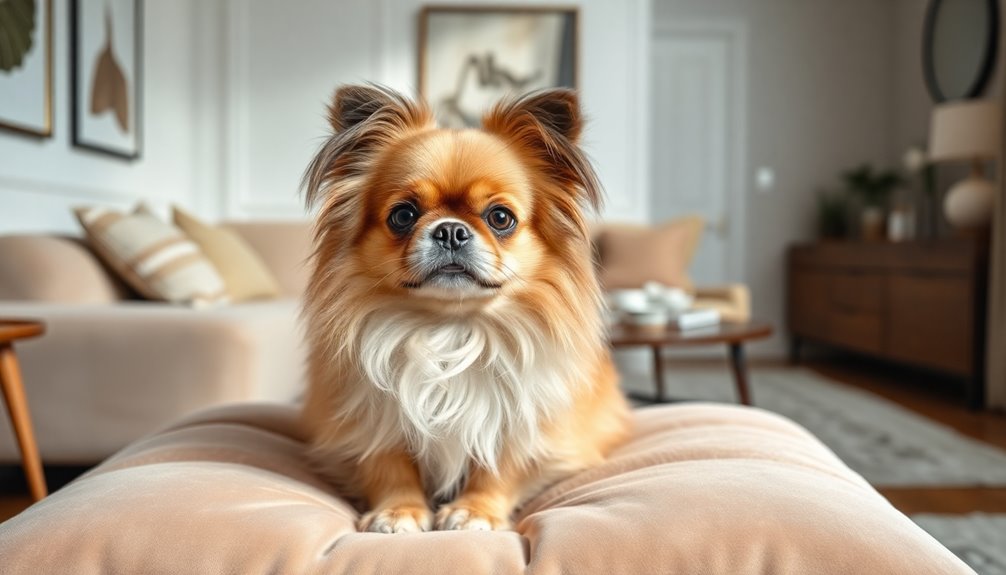
If you're considering a Japanese Chin for apartment living, you'll find they're perfect for seniors and singles alike.
Their small size and moderate activity level mean they adapt well to smaller spaces, but keep in mind their grooming needs and maintenance requirements. Regular brushing and care are essential to keep them healthy and happy in your cozy home. Additionally, their affectionate and loving nature makes them an ideal companion for those who appreciate a cat-like temperament.
Great for Seniors and Singles
The Japanese Chin makes an excellent companion for seniors and singles, especially in apartment settings. Their small size—typically standing between 8 and 11 inches tall and weighing less than 12 pounds—makes them perfect for cozy living spaces.
With a moderate activity level, they adapt well to various environments, thriving in apartments as long as they get daily walks and short play sessions. These dogs are considerate neighbors too, as they've a low barking level.
While they need attention and exercise to prevent boredom and anxiety, they don't require extensive amounts of physical activity. Slow walks and indoor playtime keep them happy and healthy. Activities like interactive toys or puzzle feeders can provide great mental stimulation. Additionally, the Japanese Chin is prone to health issues such as dental disease and obesity, so regular veterinary check-ups are essential to ensure their well-being.
The Japanese Chin is friendly, loyal, and loving, making them ideal companions. However, they can be standoffish with strangers and may develop separation anxiety if left alone for too long.
It's crucial to spend quality time with them, as they thrive on interaction. With a lifespan of 10 to 12 years or more, you can enjoy many years of companionship with this charming breed.
Grooming Needs and Maintenance
Maintaining a Japanese Chin's grooming routine is straightforward and well-suited for apartment living. Their long, smooth, and glossy coat doesn't mat easily, but it can tangle, so you'll want to brush it at least once a week, especially during shedding seasons. A pin brush works best to gently comb out tangles without damaging the hair. Regular brushing is essential for preventing matting and tangles in their coat. Additionally, maintaining a clean environment with an effective air purifier can further enhance their overall health by reducing allergens in the air.
You only need to bathe your Chin about once a month, or whenever they get dirty. In between baths, a dry shampoo can help manage dirt and oil. When you do bathe them, make sure to wet their hair thoroughly and use a gentle shampoo followed by a conditioner to keep the coat manageable.
Don't forget the details! Regularly check and clean their ears to prevent infections and irritation. Trim their nails frequently since they grow quickly. You should also brush their teeth a few times a week and clean around their facial wrinkles to avoid tear staining.
Start grooming early to help your Chin get used to the routine, and always check for skin irritations during grooming sessions for optimal health.
Frequently Asked Questions
Do Japanese Chins Require Special Grooming Tools?
Yes, Japanese Chins require special grooming tools to maintain their long, silky coats.
You'll need a soft bristle or slicker brush to remove loose fur, and a pin brush to tackle tangles. Regular brushing is essential to prevent mats.
For bathing, choose a mild shampoo and a light conditioner. Thinning shears help achieve a natural look.
Don't forget to have nail clippers and dog-specific toothpaste for overall grooming and hygiene.
How Much Exercise Do Japanese Chins Need Daily?
Japanese Chins need about 40-60 minutes of exercise daily, split into 1-2 short walks of 20-30 minutes each.
These walks allow them to burn off energy and explore their surroundings. You should keep the pace slow, giving them time to sniff and prance around.
Indoor activities, like puzzle toys and gentle play, can also help keep them active, especially on days when outdoor conditions aren't ideal.
Always consider their comfort and health needs.
Are Japanese Chins Good With Children?
Yes, Japanese Chins can be good with children, especially older ones who know how to interact gently.
You'll want to supervise their play to prevent any accidental injuries, given the dog's small size. Teaching kids to treat them respectfully is essential.
With early socialization, these dogs can thrive in family environments, forming strong bonds with family members.
Just be cautious around very young toddlers, as Chins are sensitive and delicate.
What Are Common Behavioral Issues in Japanese Chins?
Common behavioral issues in Japanese Chins include separation anxiety, especially if they're not given enough attention. They can become standoffish with strangers and may need early socialization to avoid this.
You might notice stubbornness during training, so using gentle methods is key. They require supervision around young children and can be sensitive to harsh treatment.
Regular exercise is vital to prevent boredom and related behavioral problems, so plan for daily activity.
How Can I Prevent Separation Anxiety in My Japanese Chin?
To prevent separation anxiety in your dog, establish a daily routine that includes both quality time and predictable alone time.
Gradually increase the duration of solitude, ensuring a comfortable space for relaxation.
Use positive reinforcement during training and socialization to build confidence.
Desensitize your dog to departure cues and provide familiar items for comfort.
Engage in regular physical and mental exercise to keep your dog happy and content when you're away.
Conclusion
In conclusion, the Japanese Chin makes a perfect companion for those seeking a regal lapdog. With its charming personality, elegant appearance, and adaptability, it fits seamlessly into various lifestyles. Whether you're living in an apartment or a house, this breed thrives on love and attention. By understanding its history, characteristics, and needs, you can enjoy a fulfilling relationship with your little royal. Consider welcoming a Japanese Chin into your life—you won't regret it!

